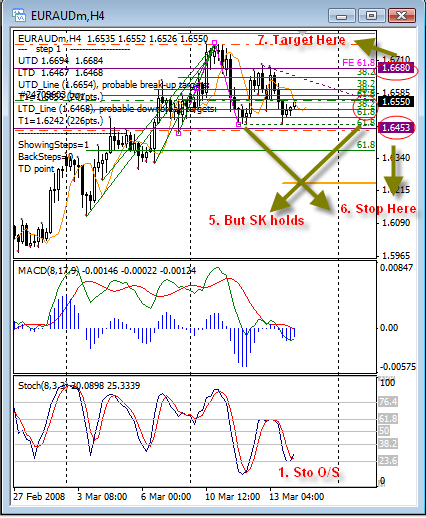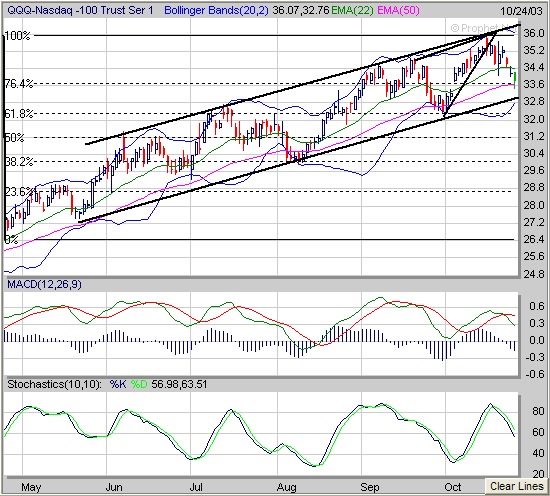The Stochastic Oscillator – a Harmonious System of Trading Traders Laboratory
Post on: 14 Июль, 2015 No Comment

In the section of technical analysis we have presented the stochastic oscillator. We have talked about what it is, how it is calculated, what its graphic representation is and how it influences trading decisions. We have also showed some examples of charts and we have explained the correct signs for entering and leaving the market in order to make a profit.
We will present here the material again but we will also add some new information to give a new perspective on this indicator. We will create a relatively simple system of interpreting financial evolution. With the help o a harmonious method we will be able to find out, step by step, in every moment, the direction of the main trend, and the most probable patterns to appear. This way we will have all the information needed to make a profitable transaction.
1. What is the “Stochastic Oscillator”?
The stochastic oscillator is a momentum indicator used in technical analysis, introduced by George Lane in the 1950s, to compare the closing price of a commodity to its price range over a given time span.
Closing levels that are consistently near the top of the range indicate accumulation (buying pressure) and those near the bottom of the range indicate distribution (selling pressure).
The idea behind this indicator is that prices tend to close near their past highs in bull markets, and near their lows in bear markets. Transaction signals can be spotted when the stochastic oscillator crosses its moving average.
Two stochastic oscillator indicators are typically calculated to assess future variations in prices, a fast (%K) and slow (%D). Comparisons of these statistics are a good indicator of speed at which prices are changing or the Impulse of Price. %K is the same as Williams’s %R, though on a scale 0 to 100 instead of -100 to 0, but the terminology for the two are kept separate.
2. How is it calculated?
This is the method of calculating the stochastic oscillator, and the values for %K and %D.
20stochastic%20oscillator/1.png /%
A 14-day %K (14-period Stochastic Oscillator) would use the most recent close, the highest high over the last 14 days and the lowest low over the last 14 days. The number of periods will vary according to the sensitivity and the type of signals desired. As with RSI, 14 is a popular number of periods for calculation
%K tells us that the close (115.38) was in the 57th percentile of the high/low range, or just above the mid-point. Because %K is a percentage or ratio, it will fluctuate between 0 and 100. A 3-day simple moving average of %K is usually plotted alongside to act as a signal or trigger line, called %D.
The %K and %D oscillators range from 0 to 100 and are often visualized using a line plot. Levels near the extremes 100 and 0, for either %K or %D, indicate strength or weakness (respectively) because prices have made or are near new N-day highs or lows.
There are two well known methods for using the %K and %D indicators to make decisions about when to buy or sell stocks. The first involves crossing of %K and %D signals, the second involves basing buy and sell decisions on the assumption that %K and %D oscillate.
In the first case, %D acts as a trigger or signal line for %K. A buy signal is given when %K crosses up through %D, or a sell signal when it crosses down through %D. Such crossovers can occur too often, and to avoid repeated whipsaws one can wait for crossovers occurring together with an overbought/oversold pullback, or only after a peak or trough in the %D line. If price volatility is high, a simple moving average of the Stoch %D indicator may be taken. This statistic smoothes out rapid fluctuations in price.
In the second case, some analysts argue that %K or %D levels above 80 and below 20 can be interpreted as overbought or oversold. On the theory that the prices oscillate, many analysts including George Lane, recommend that buying and selling be timed to the return from these thresholds. In other words, one should buy or sell after a bit of a reversal. Practically, this means that once the price exceeds one of these thresholds, the investor should wait for prices to return through those thresholds (e.g. if the oscillator were to go above 80, the investor waits until it falls below 80 to sell).
The third way that traders will use this indicator is to watch for divergences where the Stochastic trends in the opposite direction of price. As with the RSI this is an indication that the momentum in the market is waning and a reversal may be in the making. For further confirmation many traders will wait for the cross below the 80 or above the 20 line before entering a trade on divergence. The chart below illustrates an example of where a divergence in stochastics relative price forecasted a reversal in the price’s direction.
3. Chart examples for Dow and e-mini S&P 500 .
In the following examples we will use as parameters other values than the standard ones. We decided to do that because our research proved that these new values are used more and numerous well-known traders agree with them. This way the indicator has a higher precision. We will use the values of 5, 5 and 3 for %K, %D and the third parameter respectively.
Here are some examples where we also used other elements of the technical analysis already explained.
1. First we have a daily chart of Dow Jones for the firs three months of 2006. On the chart we have marked minitrends lasting 1-2 weeks. Each trend follows the previsions given by the stochastic oscillator. During these three months there have been at least seven correct sets to be followed that could generate profit.
20stochastic%20oscillator/2.jpg /%
2. This chart presents the evolution for the period August- October 2003. We can find the same setups and models. Follow closely the logic for each possible transaction.
20stochastic%20oscillator/3.jpg /%
3. The evolution of the market during June – August 2001, before the tragedy in New York: we can find nine correct sets to be trade and obtain profit.
20stochastic%20oscillator/4.jpg /%
4. A harmonious system
All the charts above (daily) present the daily evolution of Dow Jones; each candlestick represents a day. On these graphics we have marked various possibilities of entering the market and closing in profit.
The harmony of our systems refers to:
a. We start with the longest existing time-frame…let’s say we start with the weekly chart. We insert the stochastic oscillator; we analyze the aspect of the market at that point and the possible patterns beginning to form. Let’s say a LONG could form
b. We decrease the chart to a daily one. We identify the moment in time where we are, we make the same observations and try to find what the pattern is. Let’s assume it is also LONG
c. We now go to a four hours chart. We identify the moment in time and try to find a LONG signal to enter the market. If we will find a short signal or an undetermined one, we will wait. Why? We want to enter the market respecting the main trend. We look for the moment when the stochastic oscillator indicates the same thing on as many time-frames possible. So we will enter only when the four hours chart also shows a LONG signal.

d. We will study the one hour chart and also the 30 minutes chart. We wait to see a LONG signal forming. When we will find here the correct pattern we will know we have the same LONG signal on all time-frames (weekly to 30 minutes graphic). At this point all the chances are that a nice upgoing trend will start, that could last even weeks. This way we have managed to identify the trend from its starting point.
e. How will we trade? It is simple! We take the signals on the 30 minutes chart and we close step by step. The market develops in waves… up and down. The market will most certainly not go straight up. We enter long and wait until on the next time-frame (four hours chart) the direction changes. We partially mark the profit and we move the rest of the quantity on BE (break even). At this point we are relatively tranquil regarding our loos and profit. We wait on the four hours chart for the correction to take place and when the long signal appears we start looking for the same signal on the 30 minutes chart and enter again. We will close again when the 4 hours trend changes direction. We repeat the steps until the biggest time-frame we started with (in this example, the weekly chart) shows the situation has changed.
f. At this point we look for SHORT signals on every time-frame and repeat the procedure.
g. It looks easy, right? It is easy but you need a lot of patience and also some ability of reading and understanding charts.
Here are some charts to illustrate our example:
20stochastic%20oscillator/5.jpg /%
20stochastic%20oscillator/6.jpg /%
20stochastic%20oscillator/7.jpg /%
20stochastic%20oscillator/8.jpg /%
5. Conclusions
1. Although this system looks a little simplistic, it can get you a lot of pips. You only need patience and some experience in reading financial charts. Our daily analysis will of course give you step by step the direction of the day’s trend and will help you with a lot of information to support your decisions.
2. We often use the stochastic oscillator amongst other various methods of analysis that we will describe later.
Dharmik Team
- Share
- Share this post on Digg Del.icio.us Technorati Twitter














